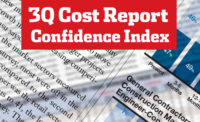Construction industry participants and observers know a downturn is coming, with market growth going on too long to last. If the question is when, the answer is not yet, according to industry executives.
 The cautiously optimistic view about a possible downturn can be seen in the latest results of the ENR Construction Industry Confidence Index survey. The CICI rose one point to 52 in the fourth quarter of 2019 from the third quarter. Many of the 283 executives from large construction and design firms responding to the latest survey believe the market’s growth has at least another six months of gas and may start to decline by the end of 2020.
The cautiously optimistic view about a possible downturn can be seen in the latest results of the ENR Construction Industry Confidence Index survey. The CICI rose one point to 52 in the fourth quarter of 2019 from the third quarter. Many of the 283 executives from large construction and design firms responding to the latest survey believe the market’s growth has at least another six months of gas and may start to decline by the end of 2020.
Currently, 18% of participants believe the market still is in growth mode, while only 6% believe its decline has started, and only 10% believe it will begin falling in three to six months. On the other hand, 32% believe the market will start to shrink by the beginning of 2021, compared to only 10% who say it will still be growing in that time frame.
The CICI measures executive sentiment about the current market and where it will be in three to six months and over a 12- to 18-month period. A rating above 50 shows a growing market. The index is based on responses to surveys sent between Oct. 28 and Dec. 9 to 6,000 U.S. companies on ENR’s lists of leading general contractors, subcontractors and design firms.
|
Related Link |
CFOs See Surprising Strength
The industry’s optimism about next year can be seen in the soon-to-be-released results of the latest Confindex survey from the Construction Financial Management Association, which measures chief financial officers’ market confidence in 2020.
Each quarter, CFMA polls 200 CFOs from general and civil contractors and subcontractors on market and business conditions based on four financial and market components, each rated on a scale of 1 to 200. A rating of 100 indicates a stable market; higher ratings indicate market growth.
“The Confindex rose from 115 in the previous quarter to 121 in the current quarter,” says Stuart Binstock, CFMA’s CEO. He says all four Confidex components rose in the fourth quarter. The business conditions component rose from 109 to 121; the financial conditions part rose from 120 to 125; and the “current conditions rose from 126 to 128.
“But the big story is that the year-ahead outlook rose from 101 to 117,” he says. In the third quarter, CFMA members were predicting what would be essentially a flat market in 2020, but this quarter, they believe the market will continue to grow next year. “That’s the ‘wow factor’ in this quarter’s survey,” Binstock says.
It’s the Economy, Stupid!
There are several reasons for the positive outlook for 2020. First, the economy has performed better than expected, says Anirban Basu, CEO of economic consultant Sage Policy Group and a CFMA adviser. Also, the Federal Reserve, which had raised interest rates nine times over the past couple years has seen no signs of inflation, so it has cut lending rates three times this year. And on Dec. 11, Fed Chairman Jerome Powell announced that the economic outlook remains favorable and that he anticipates no interest rate hikes in 2020.
According to Basu, rising interest rates in 2018 had put a crimp in project financing—as owners feared having to pay more for their projects. “But in this quarter’s survey, only 2% of CFOs said they were concerned about the availability of financing for projects,” he explains.
Further, Basu says that owners seem to be willing to absorb at least some amount of added costs resulting from higher wage rates occurring due to staff shortages so widespread in the industry.
As part of the CICI survey, ENR asked companies about their hiring plans, the positions they needed to fill and the level of raises, if any, they anticipated awarding in 2020. According to survey data, 82.8% of executives responding believe that their firms are intending to add to staffing levels in the next year.
By far, the most sought-after employees at firms are project/construction managers and superintendents, with 135 of 203 firms saying they are seeking people in these jobs. Next are engineers, with 53 firms looking for these employees. In addition, 49 of 203 firms of all disciplines say that they needed more craftworkers. Estimators are also in demand, with 32 firms looking to hire.
As for staff salaries, 88.8% of the survey respondents say that they anticipate awarding raises in 2020, with 11.2% believing salaries would remain unchanged. Of the 250 firms disclosing planned raise levels, the average wage hike will be 4.06%. This compares with 4.10% in last year’s survey and 4.16% in the 2017 survey.
No one expects the market to continue to grow indefinitely. But most industry executives believe it still has life, even those with the gloomiest outlook.
“Our members are mostly CFOs, and they are known as a pessimistic group. They have to be. It’s their job,” Binstock contends. But he emphasizes that the latest Confindex “is anything but pessimistic.”





Post a comment to this article
Report Abusive Comment